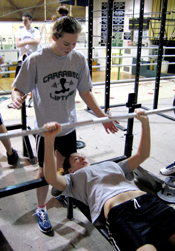
Students Tackle Childhood Obesity with Science and Teamwork
North Anson, ME—Groggy in the frozen dawn, the students arriving at Carrabec High School could be any teenagers dragging their feet on the way to school. Barely an hour later they are pumped up, shouting encouragement to each other in an unusual exercise program that is changing their attitudes about more than just fitness.
Click here for related articles from Education Week: "Tracking the Exercise-Achievement Link," July 28, 2004. "Physical Education Group Targets Childhood Obesity," May 12, 2004. "Fitness Report Cards Part of 'New PE' Movement," June 19, 2002. "PE Promotes Active Lifestyle Among Adolescents, Study Finds," June 14, 2000. "Trimming the Fat," September 1, 2004. |
|---|
Part scientific inquiry, part mission, what started as an early-morning weightlifting program has turned into something more ambitious. Taking as their challenge an issue that has troubled the nation's top health experts, this group of high school athletes in rural Maine has set out to reverse the trend toward early obesity among their peers.
Along the way, they hope to discover some factors that block teenagers from staying in healthy shape, and some previously unnoticed results when they do manage it.
For these 55 students, the mission begins at sunrise several times weekly, when they meet to work out, support each other's progress, and make plans to reach out to their schoolmates.
Kayla, 17, has gained ten pounds in the two months since she began lifting, but she says it comes from muscle where she used to have just fat.
"At first I couldn't believe what was going on," she says. "But then I learned to go by percentages instead. We judge our progress not just by what the scale says, but by a variety of scientific factors."
Her classmate Luke says he was always "chubby and unathletic." Now he has trimmed down and is proud to be a starter on the school basketball team.
 Of the 283 students at Carrabec High School, almost 20 percent have joined this program, known as Will Power. Launched by two of their teachers, Jack Kaplan and Chris Poulin, it aims beyond conditioning its members by lifting weights, stretching, and running laps.
Of the 283 students at Carrabec High School, almost 20 percent have joined this program, known as Will Power. Launched by two of their teachers, Jack Kaplan and Chris Poulin, it aims beyond conditioning its members by lifting weights, stretching, and running laps.
The program also builds in a healthy dose of science, with the help of a recent Student Research for Action grant from the Bill & Melinda Gates Foundation and What Kids Can Do. Armed with five electronic Body Composition Monitors, participants are learning to measure their percentages of body fat and muscle mass and chart their metabolic rate.
Finally, Will Power sets out to change its members' attitudes in ways it hopes will spread throughout the school, as others start to follow their examples.
Over the next several years, these teenagers will chart the progress of members and non-members of the exercise group, investigating whether physical fitness in adolescence relates to such indicators as school attendance, academic achievement, or disciplinary referrals.
Information, strength, support
With so much media attention paid to the epidemic of childhood obesity, theories of how to address the problem are sprouting left and right. Some propose low-carbohydrate school lunch menus as the answer; others would require regular physical education at all grade levels.
These teenagers have a different theory, which combines factual education and tough physical conditioning with the influential social networking that characterizes the high school years.
"A lot of people just think we're a bunch of meatheads trying to bulk up," says Jeff, 18. "But we learn a lot about how to make better choices in our lives-like eating right and not drinking on the weekends. And we learn to 'do the right thing'—which means treating people fairly and helping each other out."
That ethic of support shows up throughout a fifty-minute workout in which these teenagers lead themselves through an elaborate series of weightlifting stations, spotting a teammate during a lift or shouting encouragements. They rotate through the apparatus in small groups that match not only boys and girls, but also students of drastically different body types. Two girls may often spot a lift for a male teammate twice their height and weight.
"We're all responsible for each other," Sean says. "We all want each other to succeed. There's something about holding 200 pounds over someone that makes you take them really seriously. We could hurt each other—I mean, actually hurt each other. So it matters that we all work together."

Whose will, whose power?
Still, most of Will Power's members would occupy a particular social position in a typical U.S. high school. Aside from a few boys who have come to shed pounds, the group consists largely of long-time athletes who have never had a weight problem.
Whether that means people will imitate them or avoid them remains an open question since the weight-lifting group started in spring 2004. Participants worry that some who need the program most—seriously overweight girls, for instance—are staying away for fear of ridicule.
"Not even being able to do a single pushup—they don't want to deal with the humiliation," says Cristin, 17. "Because, despite all the things we try and do in the program, they still feel embarrassed."
 "There are definitely some of the guys who joined to lose weight, but I can't think of a single girl who started lifting for that reason," Kayla admits.
"There are definitely some of the guys who joined to lose weight, but I can't think of a single girl who started lifting for that reason," Kayla admits.
Girls signed up in greater numbers when the group began, but now only one in five Will Power members is female. Those who remain suggest that boys may be less self-conscious about their body images. But how they look is not the main point, the girls declare.
"We learn about being healthy, not necessarily being skinny," says Kayla. "We work on eating well, exercising, and being informed about how our bodies use the energy we put in them."
Jeff, who co-leads the stretching exercises at every meeting, says that Will Power has changed the way he thinks about himself. "I've never really been popular, but all of a sudden people know me," he says. "I stand up there in front leading stretches—it's really a cool feeling. Now people really look for me, they care about me. I get a lot of people calling me if I'm sick or something—they tell me that it's just not the same without me there. It's awesome to know that people appreciate it when you're around."
Boys may tend more to stick by each other, Alyssa suspects. "The guys, they all work together, a lot better than the girls. It's not as if they say, 'Hey—that fat kid over there can't do what we do.' They support each other; but it's harder for the girls."
Perhaps, Cristin says, social convention dictates that "boys who are overweight can still be popular if they are good lifters; but it's not the same for girls."
More respect, more salad
 Within the program, however, support and mutual respect have increased across gender lines.
Within the program, however, support and mutual respect have increased across gender lines.
"The guys see us there in the morning, and even if we have only ten pounds on the bar, they know we're pushing as hard as we can and they're right there cheering us on," Alyssa says. "We get a lot of respect from the guys in the program-both during the lift and throughout the day."
"No one acts differently from the way we are when we're lifting to the way we act throughout the day at school," Jeff agrees.
And participants are convinced that their example is having an effect.
"The ripple effect has been awesome—it's spread throughout the school," Sean says with pride. "We're not having the same kinds of trouble between kids as we had before. Some kids that lift with us might not even be in school if it wasn't for this."
Other habits of good health seem also to be catching on with peers who are not involved in the program.
"At lunch last year they didn't even serve salad," says Brian. "But we all started asking for it and now they serve it. With all of us eating salad, the rest of school has started, too. The cafeteria runs out of four or five tubs of lettuce every day."
"We're trying to set an example of how to take care of yourself and respect the people around you," says Sean as he hastily dries his hair before the first bell rings at 7:40. "This program isn't for everybody, that's true. But the education is. We're just hoping to light a fire."


